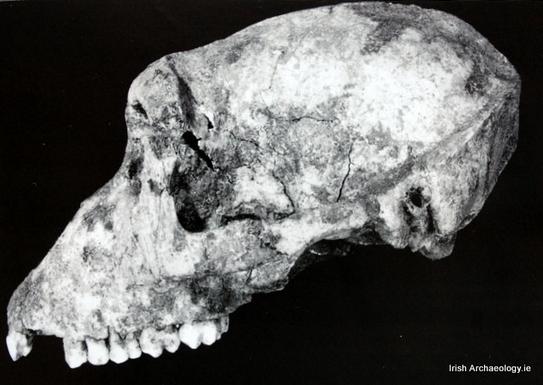African Ape in Iron Age Ireland? June 19, 2014
Author: Beach Combing | in : Ancient, Prehistoric , trackbackSo here’s a teaser. The Barbary ape is an African primate whose only toehold on the European continent is at Gibraltar, where a tiny population has survived into modern times. How, then, did a Barbary Ape get to Co Armagh in Northern Ireland in the Iron Age? Archaeologists have waxed lyrical over the find of ape remains at EM since publication of the find in 1971, and have constructed ambitious models of trade that have seen Carthaginian merchants turn up in the cold north with monkeys and other primates running up and down their rigging. And, to be fair, it is easy to understand the excitement of these archaeologists. But is everything really as it seems?
The ape appeared in phase IIIii at Emain Macha (Navan), a radical new departure for settlement in what was perhaps the capital of tribal Ulster: certainly, a fortress site that later enjoyed that status in mythology. However, the truth is that there is not the remains of a Barbary ape at Navan. There is rather the skull of an ape that was placed in a building slot, probably as a votive offering. There is a lot of misinformation out there with incorrect claims that the whole body was found; or that the skull had a chain on; or that the ape was buried at Tara: NO, NO, NO.
It is possible, of course, that no Barbary ape ever arrived in Ireland and that a skull was slowly passed from hand to hand across Europe until it arrived in this rain-swept corner of the far north. Alternatively, an ape was kept as a pet and then, at death, its skull was preserved, much as we know the ancient Celts sometimes kept human skulls as temple or domestic paraphernalia: something for which there is extensive archaeological evidence from Ireland, Britain and Gaul.
Another problem is the dating, which has been carried out on the basis of tree and radiocarbon markers. Some reports suggest the first century B.C., others the third or fourth century B.C. This lack of exactitude is worrying and though it may not sound like a big deal different dates might mean different donors. In the fourth century BC we should get all Pytheas; in the first century B.C. a Barbary Ape (or part of a Barbary ape) could have been brought, say, by Roman infiltration into the Atlantic. (There is even some unlikely muttering about the first century AD, which means Roman government in Britannia).
But let’s not spoil this too much with science. My favourite line on the subject comes from Ian Armit Head Hunting (2012, 72), ‘it is pleasing to speculate on the impact that a diminutive, hairy, tail-less, humanlike creature might have had, swinging around the timber structures of this windswept Irish drumlin.’ True or not it is an image that is difficult to relinquish.
Other animals far from home in the Iron Age? drbeachcombing At yahoo DOT com



